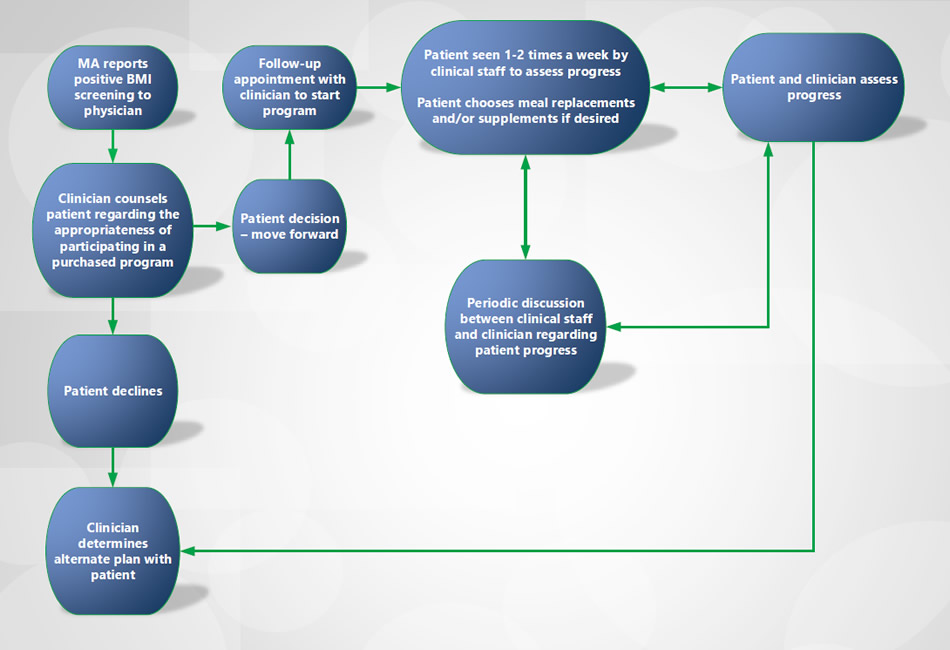Shared Content Block:
Styles -- custom quote
Shared Content Block:
Styles -- "spaced-out" class
Shared Content Block:
Styles -- "smart float" for images
Shared Content Block:
Styles -- restore normal formatting to bulleted and numbered lists
Model: Purchase or Develop a Program and Make it a Focus for Your Practice

In this model, your practice purchases or obtains a complete weight management program that is already developed. There is still the need to have the personnel to deliver the program and structure for the program (individual or group visits), but the program usually comes with the plan for delivering the program and all the instructional materials.
Why you might want to choose this model:
- Perhaps no one in your practice already has the expertise to do weight management, or no one has the time to put together a program, then purchasing an organized external program already proven to work might be ideal
- If you are willing to charge patients out-of-pocket and serve a population with the financial means to pay for services, then this model can be sustainable financially.
- If you have been frustrated with providing lifestyle advice and feel that patients need a more structured intensive program. Many of these programs are based on a high protein diet (like the Ideal Protein Program) which involves meal replacements and supplements. The results of these programs generally demonstrate better weight loss faster, although long-term sustainability of results varies.
What you have to have to make this work:
- A patient population that is able to self-pay for a structured purchased program and practice staff willing to charge patients out-of-pocket for the service
- The time and expertise to create and/or implement a self-developed or generic (non-commercial) program
- May require marketing the program
- May require a contract for delivering the program to meet specific guidelines
- May require the practice to pay an annual program renewal fee, after the practice’s initial purchase of the program
How to pay for it:
- For the medical provider portion of the visit, you can charge E&M codes or obesity codes if the patient has insurance and the services delivered meet the requirements for an E&M visit
- Some providers have specially trained medical assistants or health coaches or others provide weekly check-ins and if the medical provider reviews, these can be charged by IBT for obesity
Who can do it:
- This is dependent on the program requirements which will vary
What this model looks like in action
Patient story
This story is based on actual patient-care experiences, but is fictional. Any resemblance to real persons is purely coincidental.
Kai, a physician assistant who sees patients in a rural family medicine practice, is meeting with his patient Zoe to address her concerns about her weight and its impact on her health. She is frustrated with her lack of success in the past, and he fears she will give up quickly, despite her high level of motivation at the moment.
After discussing several options, Kai and Zoe agree that given the large amount of weight she has to lose, she may benefit the most from a structured and intensive program. The practice has a license to provide a commercial program that includes supplements and meal replacements along with weekly check-ins and medical supervision by the Kai.
Zoe has an initial visit with Kai and then comes in for weekly check-ins with his health coach, an MA who was certified to serve in this role by completing a two-week training from the commercial program. Zoe keeps track of her progress and checks in with others who are doing the same program through the program's smartphone app. Every two months, Zoe and Kai meet to discuss her progress and adjust her plan, such as increasing her exercise over time and adjusting her calories per day by adding more real foods.
After five months, Zoe's weight loss has been substantial, and her A1c and blood pressure have improved. Kai and Zoe discuss options to transition off meal replacements and plan for maintenance in the coming months. Zoe pays for the program and meal replacements out of pocket by credit card and Kai submits E&M billing for the medical visits.
Flow diagram
Based on our research, we created this diagram of a typical workflow. This is simply an example of a starting point to consider. You should create a work flow that accommodates the functioning of your practice.

FAQ
I absolutely LOVE going to [this clinic]!!! I have lost 65 lbs. in 7 months and I feel better than I ever have. I love the staff and I'm so thankful for the program.
Patient
It’s about picking an action item and then scheduling short-term follow up, so that you can then help that patient to take the next most logical step. So, I’d say the difference is that we are a lot more intimately involved with our patients. Our patients are a lot more supported, and they’re also held accountable, so I would say that we really practice participatory medicine. We really have to listen to our patients and really figure out what it is that they actually want, and just try to meet them where they are. And then try to move them on this continuum of health and wellbeing... At the end of the day, I think what we’re about is decreasing suffering and increasing well-being.
Physician